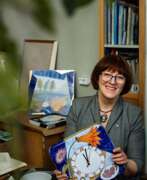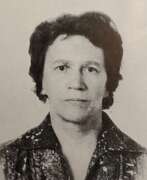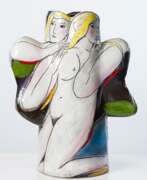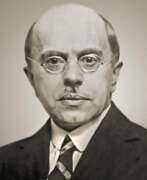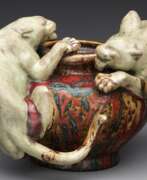Ceramists 20th century


Yō Akiyama (秋山 陽) is a Japanese ceramicist based in Kyoto. He was a late leading figure of Sōdeisha, a twentieth-century avant-garde artist group that sought to redefine understandings of aesthetics and purpose in modern and contemporary ceramics, focusing on sculptural attributes over strict functionality. Akiyama studied directly under Kazuo Yagi, one of the founders of Sōdeisha, for six years. Akiyama later became a professor at Kyoto Municipal University of Arts and Music, where he is currently a Professor Emeritus, having retired in 2018. As an artist, he works primarily with black pottery, a technique that fires clay in low temp, smoky conditions to create a dark effect. His predominantly largescale work is richly textural and abstract, emphasizing the earthy materiality of the work as well as its form.


Frederico Aguilar Alcuaz is a Filipino abstract painter, sculptor and ceramist, and master tapestry artist.
He studied painting at the University of the Philippines' School of Fine Arts, then lived and worked both in the Philippines and Spain, and in Brno, Czech Republic, he worked extensively on tapestries.
Alcuaz has earned international acclaim with his vivid abstract works in various genres and techniques, and he has exhibited extensively internationally.
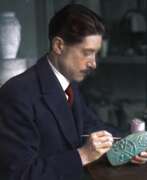

Gabriel Argy-Rousseau, born Joseph Gabriel Rousseau, was a French sculptor, ceramicist and master glassblower who contributed to the rediscovery of pâte de verre as the primary art of glass in the early twentieth century.


Charles Garabed Atamian is a French artist of Armenian origin born in Turkey.
He studied for a time at the Academy of Fine Arts in Venice, then worked as chief designer at a porcelain factory in Istanbul. In 1894, Atamian worked with a team of artists to decorate the new palace of Sultan Abdul-Hamid Il in Yildiz, on the European side of the Bosphorus. He designed, among other things, the patterns for the ceramic tiles of the palace walls.
In 1897, Atamian emigrated to France and began illustrating books and magazines, as well as working on sets for several Parisian theaters. Since 1903 Atamian participated in various exhibitions with unquestionable success. He painted landscapes, sea and beach scenes with children (including some 200 paintings at Saint-Gilles in the Vendée, where he resided each year during the summer months from 1923 to 1939). Throughout his career he was a fine portrait painter. He became a member of the National Society of Artists in 1927.


Elfriede Balzar-Kopp is a German ceramic artist.
She trained at the state ceramics engineering workshop in Höhr, worked in Karlsruhe at the State Maiolica Manufactory, and founded her own pottery workshop in Höhr in 1927.
Elfriede Balzar-Kopp initially focused on local Baroque vessels in her work and combined them with other styles. Her unique ceramic animal figurines, jugs, and genre scenes are sought after by collectors, and many of the objects she created adorn galleries around the world. Her son Heiner Balzar (born 1937) is one of the outstanding ceramic artists of the second half of the 20th century.


Marcel-Louis Baugniet was a Belgian painter, theorist, furniture designer, creator of posters, costumes and stage sets, and one of the main advocates of the concept of pure plasticity.
He studied painting at the Royal Academy of Fine Arts in Brussels, where he communicated with Paul Delvaux, René Magritte, Victor Servranck and Pierre-Louis Flouquet.


André Borderie is a French artist and sculptor.
Classically trained as a technician and working as a civil servant in the telecommunications sector, André Bordari met the poster artist Paul Colin in 1942, who encouraged him to take up painting.
A fateful meeting with the Austrian sculptors Vera and Pierre Sekely in 1946 led Bordari to the decision to devote himself entirely to art.
André Borderi is known for his paintings, tapestries and ceramics.
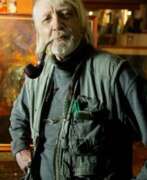

David Fielding Gough Boyd was an Australian artist, and a member of the Boyd artistic dynasty.
In 1946, he worked with his brother Guy at the Martin Boyd Pottery in Sydney. He also established a pottery studio in London in the early 1950s and continued working mainly in pottery through to the mid-1960s. In 1956, Boyd and his wife became widely known as leading Australian potters. They introduced new glazing techniques and potter's wheel use in shaping sculptural figures.
Boyd's painting career began in 1957 with a series of symbolic paintings on Australian explorers that aroused much controversy at the time, focusing as they did on the tragic history of the Aboriginal Tasmanians. In 1958 he exhibited a series of paintings based on the histological episodes in the explorations of Burke and wills and Bass and Flinders.[3] He joined the Antipodeans Group in the 1950s. Boyd discovered a technique in 1966 that he named Sfumato, after da Vinci's usage of the word to describe graduations of smoky tones in painting. Boyd's method achieved this effect through a new technique involving candle flame.


William Merric Boyd, known more as Merric Boyd, was an Australian artist, active as a ceramicist, sculptor, and extensive chronicling of his family and environs in pencil drawing.
Boyd established a studio workshop at Murrumbeena and pottery kilns were established there in 1911 with the support of his family. He studied under Bernard Hall and Frederick McCubbin at the National Gallery School and where he took up ceramics as a path to sculpture, but settled on pottery as his medium. He held his first exhibition of stoneware in Melbourne in 1912 and his second exhibition at Besant Lodge soon afterwards.
Boyd's best works were produced between 1920 and 1930; mostly pieces for domestic use, often decorated by his wife Doris, and some pottery sculptures. He and Doris often used Australian flora and fauna as decorative motifs.
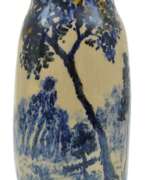

Doris Lucy Eleanor Bloomfield Boyd was an Australian artist, painter and ceramicist. Doris Gough studied under Bernard Hall and Frederick McCubbin at the National Gallery School where she met Merric Boyd, a fellow student and potter. In 1915, she married Boyd. Doris decorated many of Merric Boyd's works between 1920 and 1930. These were mostly pieces for domestic use, featuring Australian flora and fauna.


Peter Brandes is a Danish painter, sculptor, ceramic artist and photographer.
Brandes' art is abstract and often in brown colours. He had his breakthrough as artist in the beginning of the 1980s. He has, inter alia, done artwork on Roskilde Domkirke and mosaic (colored glass) windows in a church at Nordkap and the church Village of Hope, south of Los Angeles. In 1998, he created the enormous Roskilde Jars which stand outside the main Roskilde Railway Station.
Brandes is self-taught and his art circles around themes from Christianity. Ancient Greek mythology has also inspired his art. Brandes has illustrated a number of books, for example Homer’s Iliad. A great part of Brandes' ceramic works are inspired by ancient Greek art and mythology.




Roger Capron, birth name Roger Henri Louis Capron, is a French ceramic sculptor and draftsman.
Capron studied applied arts in Paris and in 1946 founded a pottery workshop, l'Atelier Callis, in Vallauris, employing up to 120 people at various times. Capron won many awards, including the Grand Prix International de la Céramique in 1970, and in 1983 he founded the now famous Atelier Capron.
Roger Capron's creations often use clay tiles or enameled lava tiles, traditionally used for decorative panels. This recognizable way of using ceramics in furniture and objects has become the designer's trademark. Capron was the first to put his ceramic expertise at the service of semi-industrial production. The workshop developed into a small factory and gained an international reputation.


Michele Cascella was an Italian artist. Primarily known for his oil paintings and watercolours, he also worked in ceramics, lithography, and textiles. He exhibited regularly at the Venice Biennale from 1924 until 1942, and his works are owned by major museums in Italy and Europe, including Victoria and Albert Museum in London, Galerie nationale du Jeu de Paume in Paris, and Galleria Nazionale d'Arte Moderna in Rome.


Andrea Cascella was an Italian painter and sculptor, a member of the Cascella dynasty of artists.
During World War II he was an active member of the Resistance in the Garibaldi Ossola formations as a training commander. Andrea Cascella also participated in the meetings of artists, directors, screenwriters, writers and poets of the 1940s-70s Menghi Osteria Brothers.
One of his most beautiful works is considered to be the monument to the fallen at Auschwitz, which he designed with his brother Pietro. Cascella also created sculptures for churches and bas-reliefs for public buildings.


Mario Ceroli is an Italian sculptor. His work has been exhibited at the Museum of Modern Art in New York City and the Mississippi Museum of Art in Jackson, Mississippi. One of his sculptures is on the Luigi Einaudi campus of the University of Turin, and another one is at the Vatican Museums.


Hans Christiansen was a German painter, representative of classical modernism, decorator and illustrator.
Christiansen trained as a decorative painter in Flensburg and then at the School of Applied Arts in Munich, later studying at the Académie Julian in Paris. After a study trip to Italy in 1889, he moved to Hamburg, where he taught at the Technical University.
At the same time, Christiansen worked as a freelance decorative artist and was active in the Volkskunst-Verein, and was one of the founders and first residents of the Darmstadt artists' colony of the late 19th and early 20th century. Together with Josef Olbrich and Peter Behrens, he designed furniture, ceramics, tapestries, stained glass and graphic posters. He also designed his own house in the colony, which he called "Villa Rose," which was destroyed during World War II.
During this time, the versatile artist also wrote regularly for the magazine Jugend, creating many illustrations and covers. From 1911 he lectured at the Wiesbaden School of Arts and Crafts and was a member of the Wiesbaden Free Artists Association.
In 1933, Christiansen's work was banned by the Nazi Party of Germany because of his Jewish wife, and he was almost forgotten until his death in 1945.


Hans Coper was an influential German-born British studio potter. His work is often coupled with that of Lucie Rie due to their close association, even though their best known work differs dramatically, with Rie's being less sculptural, while Coper's was much more abstract, but also always functional.


Dieter Crumbiegel is a German painter-painter and ceramist.
He studied ceramics at the Academy of Fine Arts in Kassel and opened his own studio in Fulda in 1964. Dieter Crumbiegel's paintings, on the other hand, convey messages that are only revealed to him while he is painting. These works have no titles; instead, they are assigned an ordinal number.
Since 1961, Crumbiegel's works have been widely exhibited both in Germany and abroad, in Australia, Ireland, Italy, Japan, Spain and Taiwan.


Hanna Dąbkowska-Skriabin is a Polish artist.
She graduated from the Academy of Fine Arts in Warsaw in the Department of Painting.
Hanna was very concerned about the fate of the human race, which is ruining itself with greed and short-sightedness. This is reflected in the works of the artist: many of her paintings are a timeless vision of a harsh world dominated by suffering and injustice. As if to protest against all this evil, Hanna Dąbkowska-Skriabin painted both paintings about love and beautiful landscapes. She is best known for her oil paintings. She has also mastered the techniques of ceramics and tapestry.




Natalya Yakovlevna Danko (Russian: Наталья Яковлевна Данько) was a distinguished Russian sculptor and medallist, celebrated for her profound contributions to the world of porcelain art. Born in 1892 and passing in 1942, Danko's journey in art commenced with rigorous training in Moscow at the Stroganov School and the City Art School, eventually leading her to significant roles in the Imperial Porcelain Factory. By 1914, she was working under the guidance of Vasiliy Lebedev, and by 1919, Danko had risen to the head of the sculpture workshop, a position she held until 1941.
Danko's oeuvre is characterized by its revolutionary spirit and exquisite craftsmanship, particularly noted in pieces like the "Red Army Soldier" (1919) and her iconic "Revolutionary chess set" (1922), which have earned her international acclaim. Her innovative designs not only reflected the political changes of her time but also showcased her mastery over porcelain, bringing a new dimension to Soviet art. Her works were showcased globally, from Paris to Monza, cementing her legacy in the international art scene.
Among her most celebrated works are the "The Reds and the Whites chess set" (1922-1932) and "Woman and Child with Fish" (1922-1923), both masterpieces of glazed and hard-paste porcelain, respectively. These pieces, housed in prestigious institutions like the Cooper Hewitt, Smithsonian Design Museum, and the Clark Art Institute, exemplify Danko's skill in blending artistic expression with social commentary, making her an important figure in both Russian and global art history.
For collectors and art and antiques experts, Danko's legacy represents a fascinating intersection of artistic innovation and historical narrative. Her works not only adorn museums but also continue to influence contemporary porcelain art, making her an enduring figure of interest.
To stay updated on sales and auction events related to Natalya Yakovlevna Danko's works, consider signing up for updates. This subscription will ensure you're informed about new opportunities to acquire pieces by this remarkable artist, connecting you directly to the rich history and ongoing legacy of Danko's contributions to art.


Juan Manuel de la Rosa is a painter, engraver, and ceramicist known for his works on handmade paper. He studied lesser-known techniques for painting and papermaking from Japan, Egypt, Fiyi and France; his handmade paper is typically made of linen, cotton, or hemp. With these traditional approaches, he creates layers and adds new dimensions to his artworks.


Edmund Arthur Lowndes de Waal is a contemporary English artist, master potter and author. He is known for his large-scale installations of porcelain vessels often created in response to collections and archives or the history of a particular place. De Waal's book The Hare with Amber Eyes was awarded the Costa Book Award for Biography, Royal Society of Literature Ondaatje Prize in 2011 and Windham–Campbell Literature Prize for Non-Fiction in 2015. De Waal's second book The White Road, tracing his journey to discover the history of porcelain was released in 2015.


André Derain was a French artist, renowned as a painter, sculptor, and a pivotal figure in the development of Fauvism alongside Henri Matisse. Born on June 10, 1880, in Chatou, Yvelines, just outside Paris, Derain's artistic journey began in his youth. Despite initially studying to become an engineer, his passion for art led him to the Académie Julian and to acquaintances with notable artists like Matisse and Maurice de Vlaminck.
Derain's work, especially his paintings, is celebrated for its vibrant, expressive use of color and innovative compositions. His contributions to Fauvism, a movement characterized by the use of bold, non-naturalistic colors, marked a significant shift in the art world. The Fauvist period, particularly his collaboration with Matisse in the summer of 1905 in Collioure, culminated in works that were distinguished by their startling hues and wild brushwork, earning them the nickname "the wild beasts" or "les Fauves."
A notable period in Derain's career was his time in London in 1906, commissioned by art dealer Ambroise Vollard. His London series, including views of the Thames and Tower Bridge, are celebrated for their unique perspective and use of color, differing significantly from the traditional depictions of the city by artists like Whistler or Monet. These works stand out for their Pointillist influence and the effective conveyance of light and movement.
Derain's artistic evolution continued as he experimented with Cubism and was influenced by African art, as seen in his primitivist woodcuts for Guillaume Apollinaire's book "L'enchanteur pourrissant" (1909). His career, however, was not without controversy, particularly during World War II, when he was perceived as a collaborator due to his interactions with the Germans.
Despite the challenges and transformations in his career, André Derain left an indelible mark on the art world. His works are held in prestigious collections worldwide, including the Musée Cantini in Marseille and the Musée d'art moderne de Troyes. Derain's contribution to modern art, particularly through Fauvism, remains a subject of admiration and study among art collectors and experts.
If you're captivated by the artistic journey and pioneering spirit of André Derain, don't miss the opportunity to stay updated on his legacy. Sign up now to receive exclusive alerts on new product sales and auction events related to André Derain's work. Embrace your passion for art and culture, and ensure you're always informed about the latest offerings and unique pieces linked to this iconic artist.


Otto D. Douglas-Hill or Otto Douglas Douglas-Hill is a German painter, sculptor, and ceramist.
He studied at the Academy of Fine Arts in Berlin, in 1926 he founded his own workshop Douglas-Hillsche, where he produced vases, garden ceramics and tableware. Douglas-Hillsche also taught at the United State Schools of Liberal and Applied Arts in Berlin. In the 1930s he won the favor of the Nazi elite and worked for them, so after World War II he had to flee to Chile, and then he moved to Spain, where he lived for the rest of his days. Douglas-Hill mainly created prefabricated vessels with glazes of his own design.


Klaus Eberlein was a German graphic artist, illustrator and ceramic sculptor. He initially completed training as a chromolithographer. From 1962 to 1968 he attended the Academy of Fine Arts in Munich, and from 1968 he was a master student of Hermann Kaspar, receiving a final diploma from the academy. Eberlein was a member of the Association for Original Etching, the Dachau Artists' Association and the Munich Artists' Association. In 2013 he was accepted into the South German literary association Münchner Turmschreiber.


Pierrette Favarger was a Swiss artist, renowned for her unique approach to ceramics and sculpture. Born in 1924, Favarger's work is distinguished by her refusal to use fire for baking her creations. This unusual technique allowed her to incorporate materials like textiles, feathers, fur, and even nails into her clay work, which could not withstand high temperatures. Her style, focusing on terracotta and the human figure, stood apart from contemporary trends, defying modern labels.
Throughout her career, Favarger participated in significant collective exhibitions, such as the one in Faenza in 1984, Zürich's Heimatwerk in 1986, and China in 1987. Additionally, her works were showcased in numerous solo exhibitions, including those at the Musée d'art et d'histoire de Neuchâtel in 1975 and 1999, and the Galerie Ditesheim in 1982 and 1990. Her distinctive work was again exhibited in 2020 at the Musée Ariana in the "Anatomie fragmentée" exhibition alongside pieces by Jean-Marie Borgeaud, Paul March, and Patriciu Mateescu.
Pierrette Favarger's career, marked by her innovative approach to ceramics, made a significant impact in the art world. Her works, which often challenged conventional ceramic techniques, are a testament to her creative spirit and technical mastery.
If you are a collector, auctioneer, or an expert in art and antiques, and wish to stay updated on new product sales and auction events related to Pierrette Favarger, sign up for our updates. This subscription is exclusively for alerts on new sales and events, ensuring you stay informed about the latest in this field.


Bryan Ferry is an English singer and songwriter. His voice has been described as an "elegant, seductive croon". He also established a distinctive image and sartorial style: according to The Independent, Ferry and his contemporary David Bowie influenced a generation with both their music and their appearances. Peter York described Ferry as "an art object" who "should hang in the Tate".


Alfred William (Willy) Finch was a ceramist and painter in the pointillist and Neo-Impressionist style. Born in Brussels to British parents, he spent most of his creative life in Finland. In 1883 he became a founding member of Les XX, a group of twenty Belgian painters, designers and sculptors, who rebelled against the prevailing artistic standards and outmoded academism. He was impressed by the works of Georges Seurat and Paul Signac and changed his own painting style from a more realistic approach into a pointillistic style. In the following years, Finch became one of the leading representatives of his style in Belgium, along with Théo van Rysselberghe. During the early 1890s Finch switched careers from painting to pottery, upon the realization that he couldn't make a living by painting. In 1897, invited by count Louis Sparre, Finch moved to Porvoo, Finland, to head the Iris ceramics factory, and influenced the development of the local Jugendstil. After the factory was closed, Finch resumed his painting career.


Salvatore Fiume is an Italian artist known for his diverse talents including painting, sculpture, ceramics and graphic design.
Salvatore Fiume's artistic style has evolved throughout his career, reflecting various influences. Fiume's paintings are characterised by vivid colours, dynamic brushwork and a sense of emotional intensity. He was also a skilled sculptor and created many sculptures in different materials.


Tsugouharu Foujita was a French twentieth-century artist of Japanese descent. He is known for his unique style, combining elements of Japanese painting and printmaking with European realism.
Foujita created a wide range of works in a variety of genres, including nudes, images of cats, portraits of women and children, and self-portraits. He later converted to Catholicism and began creating paintings with religious themes. The artist was internationally recognized, and his work was exhibited in many countries around the world. His work was characterized by the perfection of pictorial technique, virtuosity of drawing and an atmosphere of sophistication. The master also showed talent in graphics, photography, ceramics, theater, cinema and fashion design. Prices for his paintings were comparable to those of Picasso's works.


Elizabeth Fritsch (born 1940) is a British studio potter and ceramic artist born into a Welsh family in Whitchurch on the Shropshire border. Her innovative hand built and painted pots are often influenced by ideas from music, painting, literature, landscape and architecture.


Emile Gallé was a French artist and designer who worked in glass, and is considered to be one of the major innovators in the French Art Nouveau movement. He was noted for his designs of Art Nouveau glass art and Art Nouveau furniture, and was a founder of the École de Nancy or Nancy School, a movement of design in the city of Nancy, France.




